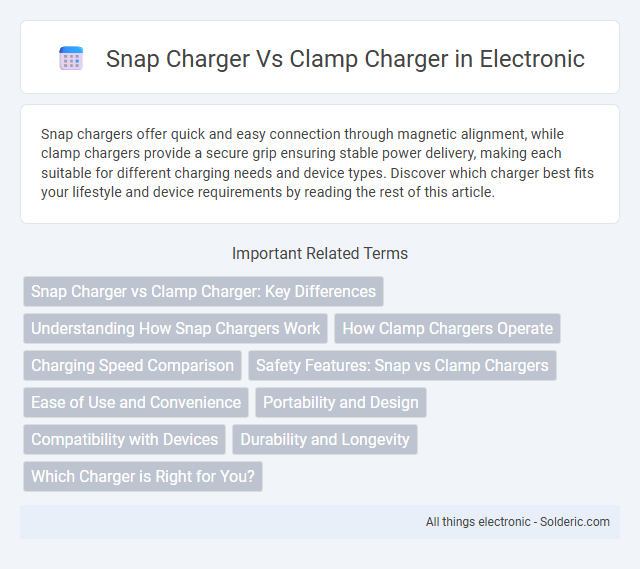Snap chargers offer quick and easy connection through magnetic alignment, while clamp chargers provide a secure grip ensuring stable power delivery, making each suitable for different charging needs and device types. Discover which charger best fits your lifestyle and device requirements by reading the rest of this article.
Comparison Table
| Feature | Snap Charger | Clamp Charger |
|---|---|---|
| Connection Type | Magnetic snap-on | Mechanical clamp |
| Ease of Use | Quick, effortless attachment | Requires manual clamping |
| Charging Efficiency | Stable, consistent contact | Variable based on clamp tightness |
| Compatibility | Designed for specific devices | Universal, adjustable for different battery sizes |
| Durability | Less mechanical wear | Potential wear from clamping pressure |
| Portability | Compact and lightweight | Bulkier due to clamp mechanism |
| Safety | Reduced risk of short circuits | Requires careful handling to avoid sparks |
| Cost | Generally higher due to magnetics | Typically more affordable |
Snap Charger vs Clamp Charger: Key Differences
Snap chargers provide a secure, quick connection using a magnetic or snap-on mechanism ideal for ease of use and portable devices. Clamp chargers deliver a robust, adjustable grip using spring-loaded clamps, suitable for heavy-duty battery charging and varying terminal sizes. Key differences include connection method, application versatility, and user convenience.
Understanding How Snap Chargers Work
Snap chargers secure directly onto the battery terminals through strong magnetic connectors, enabling efficient and stable charging without the need for clamps. These devices use integrated sensors to monitor voltage and current, ensuring optimal charging conditions tailored to your battery's health. You benefit from a safer, cleaner connection process that minimizes sparking and damage compared to traditional clamp chargers.
How Clamp Chargers Operate
Clamp chargers operate by securely gripping the battery terminals with heavy-duty clamps that establish a stable electrical connection, allowing efficient current flow for charging. The clamps are typically attached directly to the positive and negative posts, ensuring minimal resistance and enhancing charging speed. This method provides a reliable and straightforward setup, especially for automotive and deep-cycle batteries.
Charging Speed Comparison
Snap chargers typically offer faster charging speeds due to their direct contact design, minimizing energy loss and enhancing power transfer efficiency. Clamp chargers, while versatile and secure for various battery types, generally provide slower charging rates because of their indirect connection and increased resistance. Your choice impacts charging time significantly, with snap chargers preferred for rapid, efficient power delivery.
Safety Features: Snap vs Clamp Chargers
Snap chargers offer enhanced safety features with their secure magnetic connection that prevents accidental disconnections and reduces the risk of electric shock or short circuits during charging. Clamp chargers provide strong physical grip but can pose safety concerns if clips slip or cause sparks from improper contact with battery terminals. Advanced Snap chargers often include built-in overcharge protection, temperature sensors, and automatic shutoff to ensure safer battery maintenance compared to traditional clamp designs.
Ease of Use and Convenience
Snap chargers offer superior ease of use with their simple design, allowing you to quickly attach and detach the charger without the need for precise alignment or tools. Clamp chargers, although secure, often require more effort and time to properly position the clamps on battery terminals, making them less convenient for frequent use. For everyday charging tasks, the snap charger's user-friendly mechanism enhances convenience by reducing setup complexity and speeding up the charging process.
Portability and Design
Snap chargers feature a compact, lightweight design that enhances portability, making them ideal for users who need a convenient charging solution on the go. Clamp chargers tend to be bulkier due to their robust clamps and heavier construction, which can limit ease of transport. Your choice between snap and clamp chargers should consider how much you value portability versus the design's practicality for your charging needs.
Compatibility with Devices
Snap chargers offer broad compatibility with a wide range of devices, especially those designed for quick and secure attachment points such as electric scooters and e-bikes. Clamp chargers are more versatile for irregularly shaped batteries and devices lacking specific connectors, accommodating different voltage and size requirements. Your choice depends on the device's charging port design and whether ease of connection or adaptability is a priority.
Durability and Longevity
Snap chargers feature robust connectors designed for quick attachment and detachment, reducing wear and tear over time, while clamp chargers rely on spring-loaded clamps that may weaken or lose grip with frequent use. The durability of snap chargers generally leads to longer lifespan and consistent performance, making them more reliable for repeated charging cycles. Your choice should consider how often you charge and handle the device, as snap chargers typically offer enhanced longevity compared to clamp chargers.
Which Charger is Right for You?
Snap chargers offer quick, secure connections ideal for fast charging and portability, making them perfect for users who prioritize convenience and frequent on-the-go use. Clamp chargers provide a stable, reliable grip with enhanced safety features suited for long-term battery maintenance and heavy-duty applications, favored by those needing consistent charge performance. Choosing the right charger depends on your charging frequency, device compatibility, and preference for portability versus stability.
Snap charger vs clamp charger Infographic

 solderic.com
solderic.com